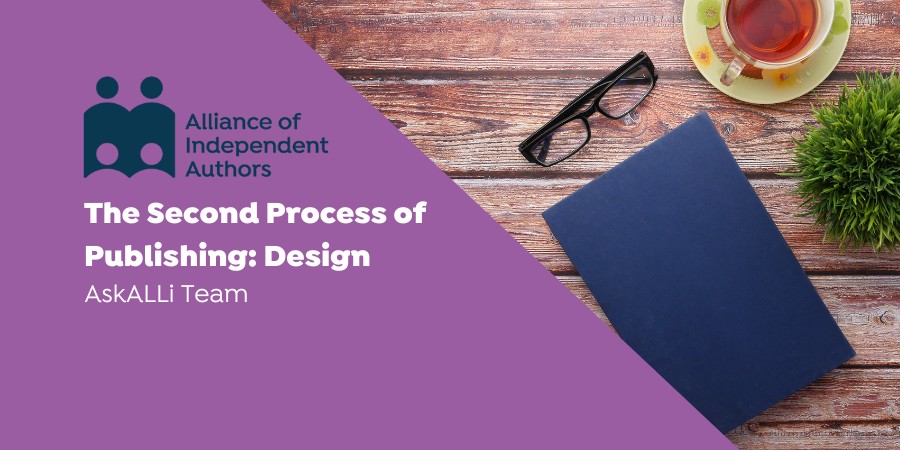In order to publish a book you have to follow the seven processes of publishing. Over the course of the rest of the year, the Alliance of Independent Authors AskALLi team is going to cover all seven processes. Today, we're examining the design process.
An overview of the seven processes can be found in this post. The rest of the processes can be found here:
If you're looking for a designer, you can use ALLi's approved partner member directory by logging into the member website and navigating to APPROVED SERVICES.
The Seven Processes of Publishing: Design
Getting a first look at your first book cover is one of the most exciting moments in an author’s life. It’s often the first time your book feels real. The cover is the first thing the reader sees, the first thing that grabs their interest and draws them to pick up your book. So you want a cover that communicates to the reader what the book is about, and makes it stand out visually for the right reasons.
It’s important that whoever is designing the book understands what your reader expects and what is usual in your genre, niche and micro-niche.
Unless you are a book designer, ideally you need to hire one. At ALLi, we encourage indie authors to focus time and attention on the work that only we can do (writing and building our author platform), and to hire other publishing professionals for the rest, wherever possible.
If you get the cover right, your sales can improve dramatically. If you get it wrong, it doesn’t matter how good your book is. It’s likely to be ignored. According to tests conducted by the book promotion company BookBub, a book’s cover alone can make a 30% difference to whether it gets clicked on a listing or not. This is not something you want to skimp on.
You can get away with pre-made covers, many indie authors do, but whatever way you choose, make the cover the centerpiece of your book’s production and marketing efforts, and give this important element of your book the time, money and attention it deserves.
Book Cover Elements
Book covers work best when the cover communicates, in shorthand, the experience the reader can expect to have. The ideal cover synchs with genre exceptions but has a unique and attractive emotional resonance.
The basic book cover formula is a single intriguing image, and an easy-to-read title and author name. Any book cover has five basic elements:
- Title.
- Subtitle, tagline, series statement, or testimonial/blurb—a short, catchy sentence to pique the reader’s interest. The tagline will also help a designer catch the soul and spirit of your book. You might have testimonials from readers of this book or your previous titles.
- Author name.
- Foreground.
- Background.
When you understand the cover elements, you can address each one with your designer, and you can make more informed decisions when looking at other books in your genre. Do all the covers in your genre have a city in the background, or a lone woman in the foreground, for example?
If you figure out the commonalities in your genre for each cover element, you can make sure your cover matches, or departs from, what’s currently working in your genre—from a position of intentional choice.
How to Brief Your Book Designer
Identify your target audience: This is the first rule in marketing, business and self-publishing. Before you even consider hiring a designer, do proper research on your ideal reader for this book. A good idea is to create an audience persona and analyze its needs and expectations. Start with demographics. Answer questions like:
- What age are your potential readers? Gender? Ethnicity? Sexual orientation? Occupation?
- What’s their income level and what type are they? The well-off can be more “posh” than “dosh”, or vice versa, for example.
- What education level do they read at?
Next, dig into psychographics: your readers’ interests, activities, and opinions.
- What values are my potential readers looking for in the book?
- What life challenges might they be dealing with?
- What’s their cultural background?
- How about their desires, fears, and needs?
Once you’ve got your answers to these questions, compress the information. Don’t share all that with your designer, summarize it into key ideas. Provide references and examples. Go onto Pinterest, Instagram or Google, and see what catches your attention. Make screenshots and notes and attach them for the designer to see.
Give as much detail as possible. Share your tastes and ideas. Pay attention to all the things you’d like to see on the cover and describe them as clearly as possible. Be clear and precise with the designer about the message you want to deliver, the spirit of your book, any plot elements or characters you’d like to see on the cover, and the setting. Explain too, any colors, fonts and images you’d rather avoid.
- Genre: you absolutely must specify the book genre. Representing the genre well is one of the primary responsibilities of a great book cover. If you are writing in a less common niche, include a description of its main characteristics to your designer. If your book is a combination of a few genres, explain what’s going on.
- Description: give the designer your blurb and some commentary to explain the plot, setting, historical timeframe and characters (especially noting their appearance, outfit, gender and behavior patterns).
- Back cover information: tagline, blurb, author bio and testimonials.
- Author brand details: e.g. logo, color palette, fonts, specific graphic elements.
- What kind of cover(s) you’ll require: paperback, hardback, dust jacket or ebook.
- Images Sourcing and Attribution: When taking images from the web, use licensed images from paid libraries, e.g., iStock or Getty Images. To save on costs, you can use free libraries such as Wikimedia Commons and give credit as their guidelines require. Unsplash is a great resource that many indie authors use.
- Use high-resolution images: Images must have a resolution of at least 300 DPI for print.
Start talking to your designer in plenty of time and communicate regularly. Give constructive feedback. Don’t be afraid to say if you don’t like something. Designers are professionals and understand there will be changes to their initial concepts.
Many quote for a set number of changes, but keep going if you need to, asking for revisions until you are completely satisfied. Some authors also want to test options for their cover design (known as A/B testing) in their newsletters or on social media. Just ensure that you have a clear cost quotation in advance, citing the number of rounds included, so there are no surprises.
Pre-made Book Covers
Many designers make pre-made book covers and sell them for a smaller fee than when a cover is commissioned. These are not cover templates, used over and again, which can cause embarrassment if another author in your genre chooses the same one. When you buy a pre-made, you provide your book details and the designer puts them on the book, and then removes it from sale. Pre-mades are a cost-effective alternative for standalone books.
The thing is: quality varies. Some are poor, but some are very good.
Pre-mades are a respectable choice for an author on a budget, but pre-mades aren’t designed for your book, so it may be difficult to find one that matches the spirit of what you’re trying to achieve. And if your book is the first in a series, check whether the designer offers enough options to complete your series.
Book Cover Checklist
Once you have a possible design, evaluate the following elements.
Is it clear? A simple design is almost always better. Examine the two elements of foreground and background and how they are layered.
Can we discern the title and author name easily? How does it treat the subtitle, tagline or series statement and any testimonials?
Does the cover work at thumbnail size? This doesn’t mean all the elements have to be legible, but it must attract and intrigue. Reduce to thumbnail size and consider. If it’s a mush, it needs more work.
If the cover is for a print book, is the trim size right?
Are the typefaces appropriate for your genre? Is the mix of typography right? There should be no more than three and ideally just two typefaces on your cover: one for the title, often decorative; a different typeface for the author name (supporting the title font, without drawing attention from it) and any strapline.
How does the cover reflect what your book is about? Is it genre appropriate? Here are some possible tones for different genres:
- Non-fiction: authoritative or friendly.
- Memoir: nostalgic or dark.
- Thriller: mysterious or violent.
- Science fiction: other-worldly or technological.
- Romance: cozy or steamy.
- Young women’s fiction: fashionable fun or inspirational.
Seek feedback, but make sure your commenters are experienced in assessing covers. Friends and family are likely to love what you show them, because they love you. They don’t understand what a cover needs to do and they are likely not your target audience.
ALLi members can share covers on the member forum to get expert feedback. If you have several variations, you could use a service like PickFu to carry out split tests on cover designs (and also book titles), to assess which cover might be more appealing to your target readers.
A big advantage with self-publishing is that it is easy to change a book’s cover. If, once your book is published, you find that sales aren’t taking off in spite of great reviews, reconsider your book’s cover design. It is never too late to change it. If you'd like to read and understand more about changing book covers, our expert of the day, Jessica Bell explains how she helped to refresh a clients covers here.
First time out, cover design can be daunting, but you get better at knowing what works for your readers as you go along.
You now have a clean text and a compelling cover. Wonderful—but book design goes beyond the jacket. It’s about creating your reader’s entire experience, from the moment they are first attracted to your book, to the very last word.
Book design encompasses the chapter headings, ornamental breaks, handling of paragraphs and quotations, and much more. We draw together the design of these disparate elements in the third stage in the publishing process, production.
Jessica Bell Cover Designer

Jessica Bell – author of “Can You Make the Title Bigga”
Simply put, great covers sell books, sub-par covers do not sell books. The same considerations need to be made at all levels to ensure the author ends up with a quality cover. Here's my top-ten list:
Jessica Bell is an author and poet and highly sought-after, award-winning book cover designer. Find out more on her website or read her new book here: Can You Make the Title Bigga? The Chemistry of Book Cover Design.

J.R. Thorn also known as A.J. Flowers
ALLi Member Case Study: JR Thorn, Authorpreneur
The AskALLi team spoke to authorpreneur member, JR Thorn to understand what her experience of the design process was like.
How has the way you worked with designers (and or the way you format) changed since you first started publishing?
For cover design, my process has generally remained the same but I do have my favorite designers now. I tend to buy a premade cover for the first in series and then do customs for the sequels. I also tend to buy premades for the omnibus editions.
Interior formatting has changed slightly only because technology has advanced. I used to format using Draft2Digital's program. When Vellum came out I started using that and I still use Vellum and love it.
How do you work with designers and or formatters? Do you prebook? Do you leave it late? Do you order an entire series of covers in advance?
I'm very passionate about covers in general. I prefer to buy premades, although I'll use customs as well. It depends on the designer and on the project. It's common that I'll order an entire series of covers in advance for a few reasons, namely because my favorite designers are often booked out up to a year in advance and I don't want to be stuck without a cover.
Before my books were able to cover these costs, I worked a ton of overtime at my day job. It's not a method I'd recommend for everyone. I just really enjoy cover shopping and I'm willing to spend extra to have the cover I want. If a series isn't selling how I want it to, I won't hesitate to test out new covers on it.
The designers I work with are all actively putting out new premades and I have a great relationship with them. I run a Facebook group “Cover Addicts Unite!” and I have managed premade cover auctions to encourage more premades in the industry and influence what kind of themes were available. Some of those covers had record sales for the designers at over $5,000 for one cover. I was very proud to be a part of encouraging the kinds of sales these amazing designers deserve.
My bestselling books are a mixture of premades and customs. What's fun, though, is my bestselling book was a surprise premade that inspired a story I never would have written otherwise.
I do not work with interior formatters. Vellum works just fine for me.
What is the biggest lesson you have learned about designing your books for publication?
There's a big difference between a beautiful cover and a marketable cover. Readers judge a book by its cover. I have found that following a stronger brand and leaning closer to expected cover tropes in certain genres or niches have greatly helped my book sales and brand recognition.




